《植物化学保护》课程教学资源(英文讲稿)Storage and Disposal

Storage and Disposal Rene Kittle MSU Extension Flathead Reservation
Storage and Disposal Rene Kittle MSU Extension Flathead Reservation
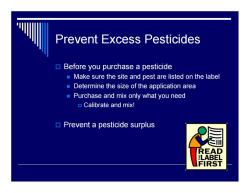
Prevent Excess Pesticides Before you purchase a pesticide Make sure the site and pest are listed on the label Determine the size of the application area Purchase and mix only what you need Calibrate and mix! Prevent a pesticide surplus READ LABEL FIRST
Prevent Excess Pesticides Before you purchase a pesticide Make sure the site and pest are listed on the label Determine the size of the application area Purchase and mix only what you need Calibrate and mix! Prevent a pesticide surplus

Disposal of Excess Mix Use extra tank mix or rinse water on areas with similar pest problems Dilute and reapply to treatment area Be careful -Don't exceed the label rate! ▣Large quantities Call the Montana Department of Agriculture
Disposal of Excess Mix Use extra tank mix or rinse water on areas with similar pest problems Dilute and reapply to treatment area Be careful - Don’t exceed the label rate! Large quantities Call the Montana Department of Agriculture

Container Disposal Make sure pesticide containers are empty Triple rinse containers into tank ■Use on labeled site Never dump rinse water (rinsate)on the ground If not,rinsate must be treated as surplus pesticide and disposed of properly
Container Disposal Make sure pesticide containers are empty Triple rinse containers into tank Use on labeled site Never dump rinse water (rinsate) on the ground If not, rinsate must be treated as surplus pesticide and disposed of properly

Triple Rinse Procedure 1. Empty container into spray tank in a vertical position for 30 seconds 2.Refill container to 1/5 with water 3.Rinse thoroughly,pour into spray tank in vertical position for 30 seconds 4. Repeat steps 2 and 3 until the container has been rinsed three times 5.Puncture or render container useless
Triple Rinse Procedure 1. Empty container into spray tank in a vertical position for 30 seconds 2. Refill container ¼ to 1/5 with water 3. Rinse thoroughly, pour into spray tank in vertical position for 30 seconds 4. Repeat steps 2 and 3 until the container has been rinsed three times 5. Puncture or render container useless
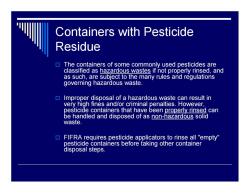
Containers with Pesticide Residue The containers of some commonly used pesticides are classified as hazardous wastes if not properly rinsed,and as such,are subject to the many rules and regulations governing hazardous waste. Improper disposal of a hazardous waste can result in very high fines and/or criminal penalties.However, pesticide containers that have been properly rinsed can be handled and disposed of as non-hazardous solid waste. FIFRA requires pesticide applicators to rinse all "empty" pesticide containers before taking other container disposal steps
Containers with Pesticide Residue The containers of some commonly used pesticides are classified as hazardous wastes if not properly rinsed, and as such, are subject to the many rules and regulations governing hazardous waste. Improper disposal of a hazardous waste can result in very high fines and/or criminal penalties. However, pesticide containers that have been properly rinsed can be handled and disposed of as non-hazardous solid waste. FIFRA requires pesticide applicators to rinse all "empty" pesticide containers before taking other container disposal steps
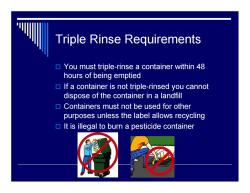
Triple Rinse Requirements You must triple-rinse a container within 48 hours of being emptied If a container is not triple-rinsed you cannot dispose of the container in a landfill Containers must not be used for other purposes unless the label allows recycling It is illegal to burn a pesticide container
Triple Rinse Requirements You must triple-rinse a container within 48 hours of being emptied If a container is not triple-rinsed you cannot dispose of the container in a landfill Containers must not be used for other purposes unless the label allows recycling It is illegal to burn a pesticide container
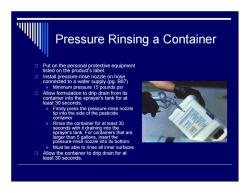
Pressure Rinsing a Container ◇ Put on the personal protective equipment listed on the product's label. Install pressure-rinse nozzle on hose connected to a water supply(pg.B87) Minimum pressure 15 pounds psi Allow formulation to drip drain from its container into the sprayer's tank for at least 30 seconds. Firmly press the pressure-rinse nozzle tip into the side of the pesticide container Rinse the container for at least 30 seconds with it draining into the sprayer's tank.For containers that are larger than 5 gallons,insert the pressure-rinse nozzle into its bottom. Must be able to rinse all inner surfaces Allow the container to drip drain for at least 30 seconds
Pressure Rinsing a Container Put on the personal protective equipment listed on the product's label. Install pressure-rinse nozzle on hose connected to a water supply (pg. B87) Minimum pressure 15 pounds psi Allow formulation to drip drain from its container into the sprayer's tank for at least 30 seconds. Firmly press the pressure-rinse nozzle tip into the side of the pesticide container Rinse the container for at least 30 seconds with it draining into the sprayer's tank. For containers that are larger than 5 gallons, insert the pressure-rinse nozzle into its bottom. Must be able to rinse all inner surfaces Allow the container to drip drain for at least 30 seconds
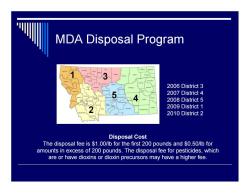
MDA Disposal Program 2006 District 3 2007 District 4 2008 District 5 2009 District 1 2010 District 2 Disposal Cost The disposal fee is $1.00/lb for the first 200 pounds and $0.50/lb for amounts in excess of 200 pounds.The disposal fee for pesticides,which are or have dioxins or dioxin precursors may have a higher fee
MDA Disposal Program 2006 District 3 2007 District 4 2008 District 5 2009 District 1 2010 District 2 Disposal Cost The disposal fee is $1.00/lb for the first 200 pounds and $0.50/lb for amounts in excess of 200 pounds. The disposal fee for pesticides, which are or have dioxins or dioxin precursors may have a higher fee

Disposal Program Montana Department of Agriculture Phone:(406)444-5400 email:agr@mt.gov What Materials does the Pesticide Disposal Program Accept? Accepted Materials Examples of Materials Not Accepted Pesticides Any non-pesticide material such as: Pesticide Mixes Plastic Containers Unknown Fertilizers Pesticides Loaded M-44s Metal Pesticide Solvents Containers Paints Oil
Disposal Program Any non-pesticide material such as: Plastic Containers Fertilizers Loaded M-44s Solvents Paints Oil Pesticides Pesticide Mixes Unknown Pesticides Metal Pesticide Containers Accepted Materials Examples of Materials Not Accepted What Materials does the Pesticide Disposal Program Accept? Montana Department of Agriculture Phone: (406)444-5400 email: agr@mt.gov
按次数下载不扣除下载券;
注册用户24小时内重复下载只扣除一次;
顺序:VIP每日次数-->可用次数-->下载券;
- 《植物化学保护》课程教学资源(英文讲稿)Plastic Pesticide Container Recycling.pdf
- 《植物化学保护》课程教学资源(英文讲稿)Pesticides.pdf
- 《植物化学保护》课程教学资源(英文讲稿)Pesticides Analysis with the new Agilent 6220 6460 and 6530.pdf
- 《植物化学保护》课程教学资源(英文讲稿)Pesticide Waste Challenges.pdf
- 《植物化学保护》课程教学资源(英文讲稿)Pesticide Toxicology and Risk Assessment.pdf
- 《植物化学保护》课程教学资源(英文讲稿)Pesticide Toxicity.pdf
- 《植物化学保护》课程教学资源(英文讲稿)Pesticide Safety and Toxicity(PPT).ppt
- 《植物化学保护》课程教学资源(英文讲稿)Pesticide Registration for Minor Crops and Crop Grouping Effort in Japan.pdf
- 《植物化学保护》课程教学资源(英文讲稿)Pesticide Laws and Regulations.pdf
- 《植物化学保护》课程教学资源(英文讲稿)Pesticide Health Hazards - Exposure and Personal Protective Equipment.pdf
- 《植物化学保护》课程教学资源(英文讲稿)Pesticide Hazards and First Aid(PPT).ppt
- 《植物化学保护》课程教学资源(英文讲稿)Pesticide Formulas and Properties.pdf
- 《植物化学保护》课程教学资源(英文讲稿)Pesticide Contamination in Rural Areas.pdf
- 《植物化学保护》课程教学资源(英文讲稿)Pesticide Toxicology(PPT).ppt
- 《植物化学保护》课程教学资源(英文讲稿)Oklahoma Unwanted Pesticide Disposal Program.pdf
- 《植物化学保护》课程教学资源(英文讲稿)No Spray Buffers Lawsuits & Toxicology.pdf
- 《植物化学保护》课程教学资源(英文讲稿)Labels and Pesticide Formulations.pdf
- 《植物化学保护》课程教学资源(英文讲稿)IPMA Primer.pdf
- 《植物化学保护》课程教学资源(英文讲稿)Integrated Pest Management for Urban Landscapes.pdf
- 《植物化学保护》课程教学资源(英文讲稿)Fungicide Use and Aerial Application.pdf
- 《植物化学保护》课程教学资源(英文讲稿)The Impacts of Adoption of Genetically Engineered Crops on Yields, Pesticide Use and Economic Returns in the USA.pdf
- 《植物化学保护》课程教学资源(英文讲稿)The Influence of Secondary Standards on Pesticide Use.pdf
- 《植物化学保护》课程教学资源(英文讲稿)Toxic Effects of Pesticides.pdf
- 《植物化学保护》课程教学资源(英文讲稿)TOXICOLOGY III Risk Assessment(PPT).ppt
- 《植物化学保护》课程教学资源(英文讲稿)Work and Residential Characteristics Related to Pesticide Exposure among Latino Farmworkers.pdf
- 华南农业大学:《普通昆虫学》课程教学大纲(负责人:王敏).pdf
- 华南农业大学:《普通昆虫学》课程授课教案(讲义,共五篇).docx
- 华南农业大学:《普通昆虫学》课程教学资源(实验指导)实验一 昆虫体躯的基本结构和昆虫的头部.pdf
- 华南农业大学:《普通昆虫学》课程教学资源(实验指导)实验二 昆虫的胸部和腹部.pdf
- 华南农业大学:《普通昆虫学》课程教学资源(实验指导)实验三 昆虫的卵、胚胎发育和胚后发育.pdf
- 华南农业大学:《普通昆虫学》课程教学资源(实验指导)实验四 昆虫纲分目(Ⅰ).pdf
- 华南农业大学:《普通昆虫学》课程教学资源(实验指导)实验五 昆虫纲分目(Ⅱ).pdf
- 华南农业大学:《普通昆虫学》课程教学资源(实验指导)实验六 等翅目、直翅目和缨翅目分科.pdf
- 华南农业大学:《普通昆虫学》课程教学资源(实验指导)实验七 半翅目和脉翅目分科.pdf
- 华南农业大学:《普通昆虫学》课程教学资源(实验指导)实验八 同翅目分科.pdf
- 华南农业大学:《普通昆虫学》课程教学资源(实验指导)实验九 鞘翅目分科.pdf
- 华南农业大学:《普通昆虫学》课程教学资源(实验指导)实验十 鳞翅目分科(成虫).pdf
- 华南农业大学:《普通昆虫学》课程教学资源(实验指导)实验十一 鳞翅目分科(幼虫).pdf
- 华南农业大学:《普通昆虫学》课程教学资源(实验指导)实验十二 双翅目科.pdf
- 华南农业大学:《普通昆虫学》课程教学资源(实验指导)实验十三 膜翅目分科.pdf
